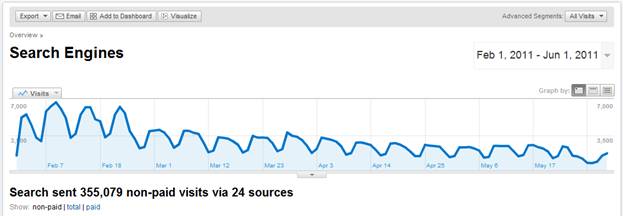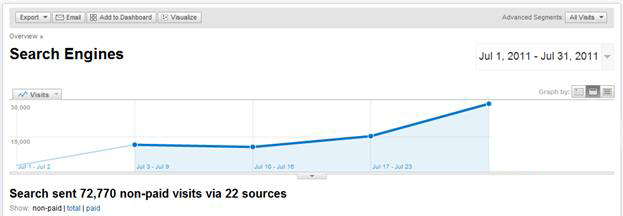Many websites have been impacted by Google’s Panda updates since February – perhaps including the most recent 2.3 update. Others live in fear of the next updates. Webmasters across the country are looking for quick answers and quick fixes.
Those impacted may find themselves asking, “Who do these Google engineers think they are? They’re driving traffic away from my site as opposed to towards it, what kind of ‘search engine’ is this?” While many people might share your sentiments, this attitude isn’t going to help you recover traffic. Moreover, there may be quick answers but the best “fixes” involve investing in long-term content marketing solutions to improve visitors’ experiences of your site.
A CEO of a company recently came to Brafton with some post-Panda woes. As of February 26th, the site’s organic traffic from Google was cut by nearly 84 percent (and dropping).

It’s easy to blame Google for this site’s loss in revenues since February. “Why is Google targeting my website?” Well, it isn’t – Google is perfecting its search product. Google’s target audience is anyone who can figure out how to use the internet. If your site was Pandalized, there is something about your site that Google believes wouldn’t be useful to searchers.
After looking at this CEO’s site, there were a few issues that jumped out to me, all of which caused confusion or difficulty for me as a user:
- The navigation consisted of identical drop downs which had similar anchor text all linking to different, but very similar, landing pages.
- There were four to five ads on each content page.
- Some articles were less than 200 words long. That being said, the ads took up well over 75 percent of these content pages.
- There were a huge number of internal links, but an extremely low number of external links.
To rectify these issues, we first worked with the company on developing new landing pages. Now, each page covers a more specific, individual topic with unique content. Next, we worked on removing some of the ads. While many marketers may be resistant to taking down ads, industry analysts have agreed that ad to content ratio can be a problem for Panda.
Then, we set a content marketing plan that would focus on reader-friendly articles. Highly editorial content is not only good for readers, but Google has suggested that it’s necessary for modern SEO. You can keep the content somewhat keyword-heavy, as long as the keywords make sense in the context of the articles.
In the content strategy, we also made it a point to link to resources (including resources published on other online destinations). As Brafton has reported, some experts suspect that consumer engagement might play into post-Panda rankings, so it’s better to offer consumers information and send them resources than to send them back to search engines.
With these strategies in place, we’ve seen the site’s traffic climb back up to normal levels. We watched the traffic closely, seeing recovery around mid-July and traffic has continued to build steadily through the newest Panda 2.3 Update.

Now I’m not saying that these four issues are what always cause a site to be Pandalized, nor am I saying that if you make these exact changes your site will recover or be immune to updates.
What I am trying to say is that it’s worthwhile to have a second set of eyes take a look at your site; you look at it every day and a fresh eye could mean the difference. It’s good to get perspective on ways to increase the user experience, prove you’re an authoritative site and show that you only have the best intentions for your traffic. Thinking about the value of your content to site visitors is the simplest way to think about Panda recovery. If you make appropriate updates, you will probably fare better when it comes to Panda.
Want more tips on ways to survive (or recover from) Panda? Check out Brafton’s related blogs (Panda recovery part one and two) with expert insight from SMX Advanced on post-Panda SEO.

